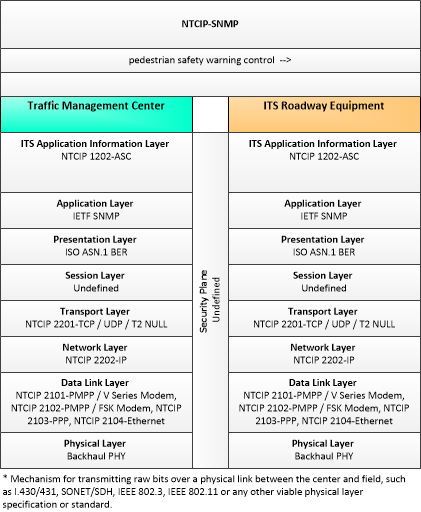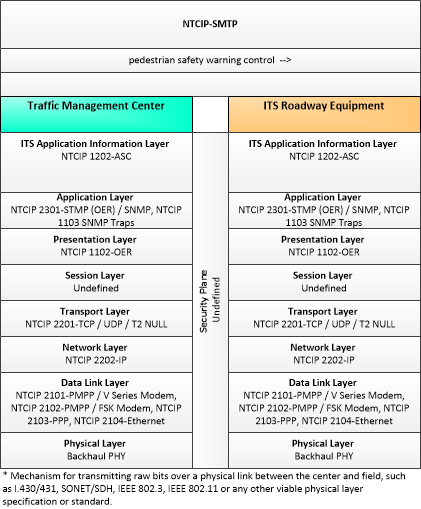Link Type: Center to Field
Traffic Management Center --> ITS Roadway Equipment:
pedestrian safety warning control
Definitions
pedestrian safety warning control (Information Flow): Configuration and control of equipment that monitors and manages pedestrian crossings and provides visual displays and warnings to drivers when pedestrians are occupying a cross walk.
Traffic Management Center (Source Physical Object): The 'Traffic Management Center' monitors and controls traffic and the road network. It represents centers that manage a broad range of transportation facilities including freeway systems, rural and suburban highway systems, and urban and suburban traffic control systems. It communicates with ITS Roadway Equipment and Connected Vehicle Roadside Equipment (RSE) to monitor and manage traffic flow and monitor the condition of the roadway, surrounding environmental conditions, and field equipment status. It manages traffic and transportation resources to support allied agencies in responding to, and recovering from, incidents ranging from minor traffic incidents through major disasters.
ITS Roadway Equipment (Destination Physical Object): 'ITS Roadway Equipment' represents the ITS equipment that is distributed on and along the roadway that monitors and controls traffic and monitors and manages the roadway itself. In CVRIA, this physical object represents all of the other ITS field equipment that interfaces with and supports the Connected Vehicle Roadside Equipment (RSE). This physical object includes traffic detectors, environmental sensors, traffic signals, highway advisory radios, dynamic message signs, CCTV cameras and video image processing systems, grade crossing warning systems, and ramp metering systems. Lane management systems and barrier systems that control access to transportation infrastructure such as roadways, bridges and tunnels are also included. This object also provides environmental monitoring including sensors that measure road conditions, surface weather, and vehicle emissions. Work zone systems including work zone surveillance, traffic control, driver warning, and work crew safety systems are also included.
Included In
This Information Flow is in the following Applications:
This Information Flow is in the following Application Objects:
Communication Diagrams
The communication diagram(s) can be viewed in SVG or PNG format and the current format is SVG. Switch to PNG format.
This profile describes an alternative set of standards used to communicate with ITS Roadway Devices that uses the NTCIP Octet Encoding Rules (OER), a standard developed specifically for the transportation industry. This template is used primarily for communication with traffic signal controllers, where second-per-second communications is required. This template also includes standards for SNMP traps, that allows an ITS Roadway Device to initiate event-driven communications with a receiver.
Characteristics
Architectural:
| Characteristic | Value |
|---|---|
| Time Context | Recent |
| Spatial Context | Local |
| Acknowledgement | True |
| Cardinality | Unicast |
| Initiator | Source |
Security
This information flow triple is in the following applications with the following security levels.
| Information Flow Security | |||||
|---|---|---|---|---|---|
| Application | Confidentiality | Integrity | Availability | ||
| Basis | Basis | Basis | |||
| Pedestrian in Signalized Crosswalk Warning | Moderate | Moderate | Low | ||
| o Application configuration: The displays and warnings on the controlled device are not confidential, so messages containing possible displays and warnings or setting the conditions under which they are displayed should not be confidential. O Device management: If this information flow includes device management as well as display and alert configuration, the device management may include proprietary information about the particular device being managed such as firmware details, memory size, processor limitations etc. The confidentiality requirement for the roadway equipment should be set by the supplier based on their understanding of the confidentiality requirements of the management messages. Note that the supplier can be assumed to provide devices that meet their own security requirements; however, the confidentiality requirements of this flow will also apply to the TMC. |
Fake instances of this information flow can cause drivers and pedestrians to get incorrect information. However, it would not be possible to put the traffic signal into an inconsistent | Assuming that the traffic signal is configured reasonably well to start off with, the system should be robust if it goes an arbitrary amount of time without reconfiguration. | |||

